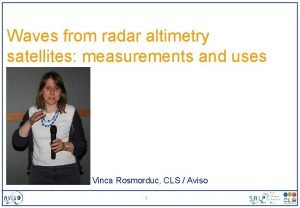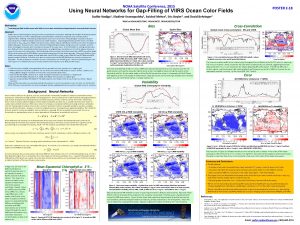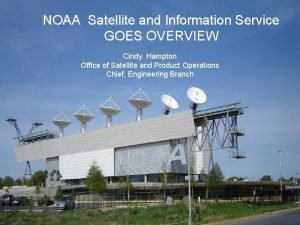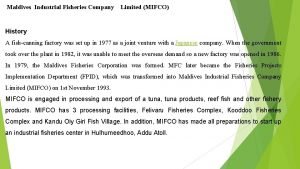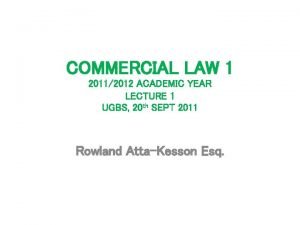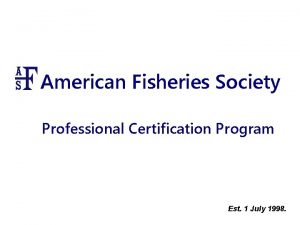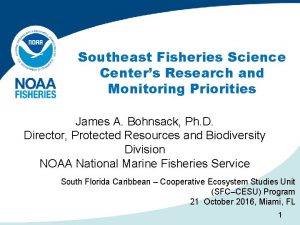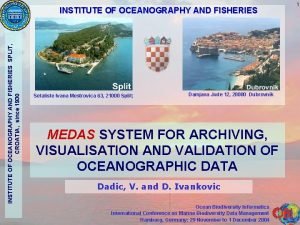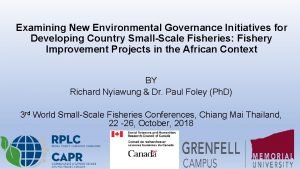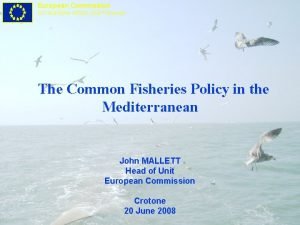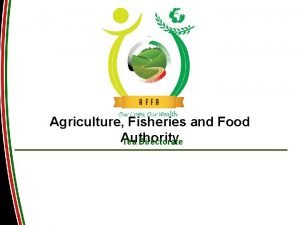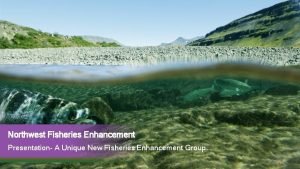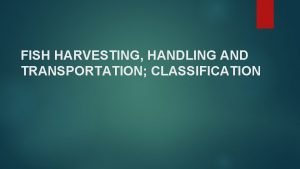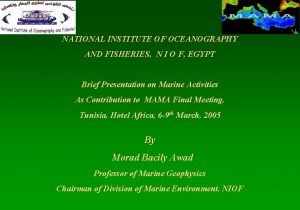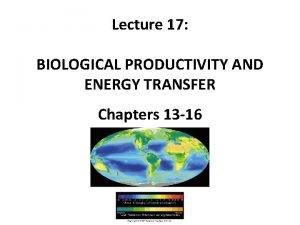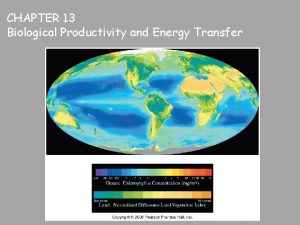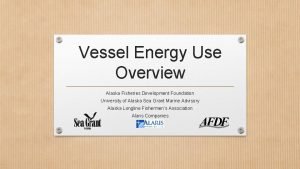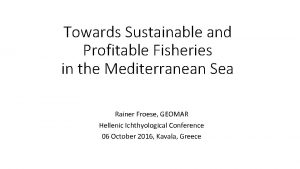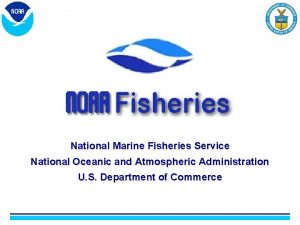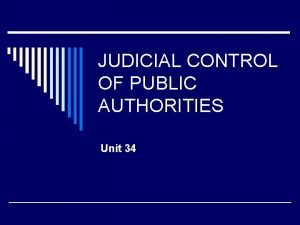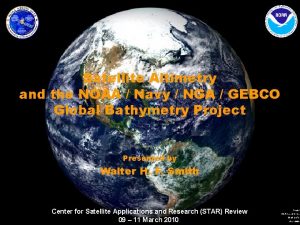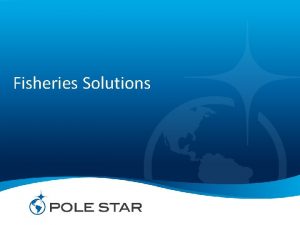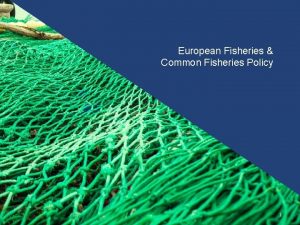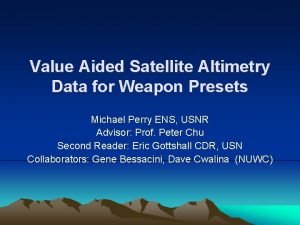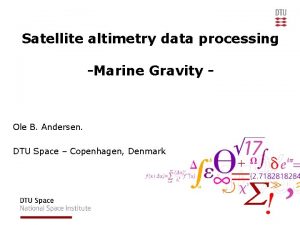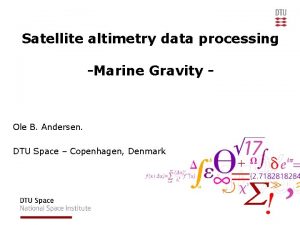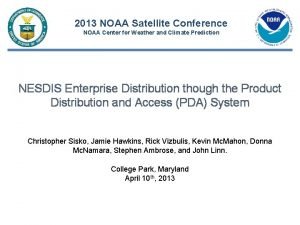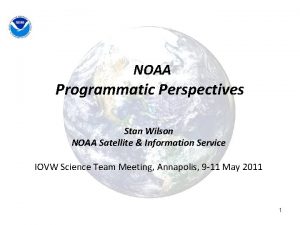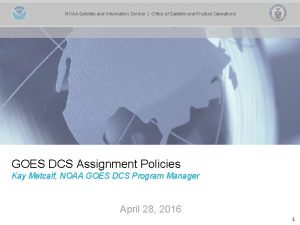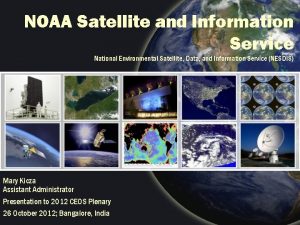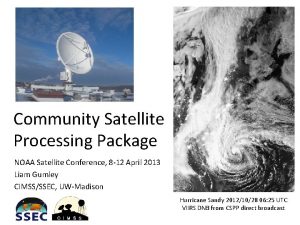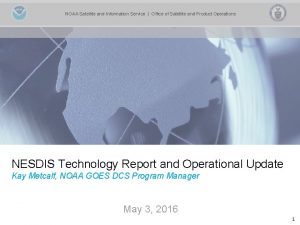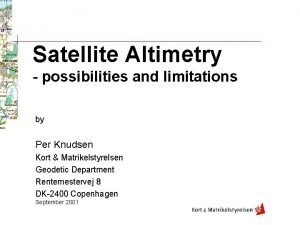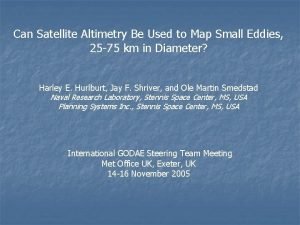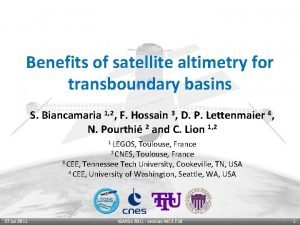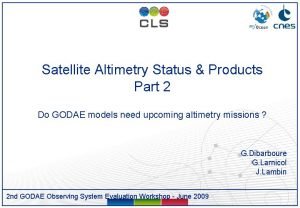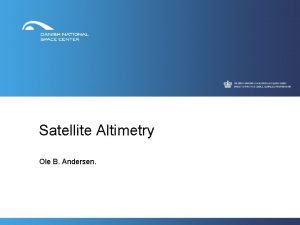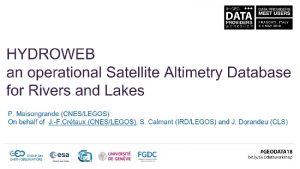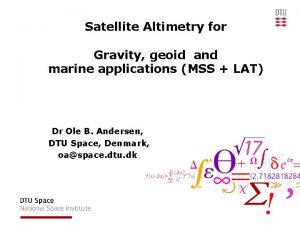NOAA Fisheries Satellite Altimetry Data An Overview NOAA
























- Slides: 24

NOAA Fisheries & Satellite Altimetry Data An Overview • NOAA Fisheries (NMFS) mandate is to act as a steward of living marine resources, which involves ecosystem and habitat characterization and stock assessment (i. e. NMFS does not help fishers find fish). • Better characterization of the coastal zone is of interest to NMFS since many commercial and recreational fisheries are focused in the coastal zone. • Altimetry data is commonly used in the open ocean to provide an environmental context to tracked animals, in particular how animals interact with mesoscale features. • Coastal measurements of velocity and transport would be useful to NMFS. The west coast node of Coast. Watch is planning to implement a near shore transport product to better engage coastal resource managers.

NOAA Fisheries & Coastal Altimetry Data Cara Wilson NOAA/NMFS/SWFSC Environmental Research Division (ERD) 1352 Lighthouse Ave. , PG, CA Coastal Altimetry Workshop, Silver Spring, MD Feb 5 -7 2008

NOAA Fisheries (NMFS) • NOAA Fisheries (NMFS) is responsible for managing over 900 fish stocks (stock assessment). • In addition, NMFS manages ~260 protected or endangered species. • NMFS is transitioning to ecosystem approaches to management. - Ecosystem characterization of tagged species - Improving stock assessments • NMFS does not help fishermen find fish

Fisheries focused in Coastal Zone CA 2006 Landings Coastal (0 -3 miles) EEZ (3 -200 miles) High Seas (>200 miles) Source: NOAA Fisheries Office of Science & Technology Dollars $27 M $101 M 78% Weight 62 M lbs 278 M lbs 82%

Ocean Features Important to Ecosystems • • • Ocean ‘fronts’, boundaries, ‘edges’ River plumes Coastal regions Mesoscale circulation patterns: eddies, meanders, ‘loops’ Convergence zones Subsurface thermal structure: MLD, thermocline Ocean surface winds Ocean currents Wave heights All of these ocean features can be measured, detected, or inferred by satellite data

Temporal Events Important to Ecosystems Upwelling Harmful Algae Blooms (HABs) Oil Spills Seasonal Transitions El Niño events Regime Shifts (i. e. PDO) Global Climate Change Climate change can affect the timing and/or intensity of many of these processes Climate Data Records (CDRs) of satellite measurements need to be maintained!

Some Example Applications Coastal Altimetry Workshop, Silver Spring, MD Feb 5 -7 2008

Tagged Species Electronic tagging is a key methodology used by NOAA Fisheries to gather information on stock productivity and recruitment, fish behavior, feeding ecology and habitat selection– information needed for accurate and responsible fisheries management. 1 Satellite data, such as ocean color, SST, SSH and SVW, are necessary to place the telemetric data from tags in an environmental context as part of the transition to an ecosystem approach to management. 1 Report of the NMFS Workshop on advancing electronic tag technologies and their use in stock assessment. NOAA Tech. Memo. NMFS-F/SPO-82, 82 pp, 2007. http: //spo. nmfs. noaa. gov/tm

Characterizing Turtle Habitat Oct 2003 Nov 2003 Dec 2003 Jan 2004 Loggerhead turtle tracks (black line and blue arrows) NOAA/NMFS/SWFSC PFEL Polovina et al. , DSR-II, 2006 NOAA/NMFS/PIFSC

Characterizing Turtle Habitat Oct 2003 Nov 2003 Dec 2003 Jan 2004 Loggerhead turtle tracks (black line and blue arrows) overlaid over geostrophic currents (white arrows) and SSH. NOAA/NMFS/SWFSC Polovina et al. , DSR-II, 2006 NOAA/NMFS/PIFSC PFEL

Turtle Residency (days) Understanding Turtle Migration Patterns 150 Turtles prefer the Kuroshio Extension Current (KEC) in winter when chlorophyll is high. In summer, when chlorophyll decreases, they migrate north into the TZCF (transitional zone chlorophyll front). Summer Turtle Residency (days) Winter 120 90 60 30 0 150 120 90 60 30 0 Polovina et al. , DSR-II, 2006 KEC 30° 33° 36° 39° 42° 45° Latitude NOAA/NMFS/PIFSC

Simulating Larval Dispersion Satellite altimetry data used to simulate the transport dynamics of the spiny lobster, Panulirus marginatus, around the Hawaiian Islands. Polovina et al. , Fish. Bull. , 1999 NOAA/NMFS/PIFSC

Hawaiian Bottomfish Stock Assessment Hawaiian Bottomfish (snappers, groupers, jacks) • Pilot project to assess if inclusion of satellite data can improve the stock assessment of Hawaiian Bottomfish. Led by Jon Brodziak at NMFS/PIFSC. • There is a consistent pattern of negative association between SSH anomalies and CPUE (catch per unit effort) residuals for Hawaiian Bottomfish, suggesting that the inclusion of satellitederived SSH could improve the stock assessment of Hawaiian Bottomfish. • Funded in part by NASA and by NOAA’s R&O project Brodziak, J. 2007. An investigation of alternative production models to assess the Hawaiian Bottomfish complex. PIFSC, NMFS, NOAA, Honolulu, HI 96822 -2396. PIFSC Admin. Rep. H-07 -01, 69 p.

Alaskan Sablefish Project S. Kalei Shotwell & Dana H. Hanselman, NMFS/AFSC Objective Explore integrating satellite derived environmental time series (SST, chl, SSH) into the sablefish stock assessment to reduce recruitment uncertainty Sablefish (Anoplopoma fimbria) • Fast growing, wide distribution, highly valuable ($100 M) commercial species • Adults generally at 200+ meters in continental slope, gullies, fjords Early life history largely unknown • Spawning at depth, larvae swim to surface, collect at shelf break • Juveniles move nearshore to overwinter, then offshore in summer • Reach adult habitat and recruit to fishery or survey in 4 to 5 years Recruitment calculated in age-structure model • Recruitments are estimated as two year-olds • Estimates for most recent years are highly variable with large uncertainty and excluded from model projections

Questions… • The high temporal and spatial resolution of satellite data, and its continuity, make satellite data an important tool for monitoring and characterizing marine ecosystems. • Satellite data will become increasingly more important as NOAA implements ecosystem approaches to management. • Currently, however, the full potential of satellite data has not been realized within NMFS, or within fisheries science more generally. Why is satellite data underutilized within NMFS? What can be done to take advantage of the wealth of information this data can provide?

Why is satellite data underutilized within NMFS? 1) Satellite data can be difficult to access, manipulate and process, particularly for people who have never used it before. 2) Work required to get relevant parameters can be cumbersome, ie: • current/transport information from SSH • front locations from SST fields • climatologies required to generate anomalies • rigorous ‘data mining’ needed to match up satellite data with telemetry records. 3) Timeseries of satellite data are relatively short compared to many fisheries datasets. 4) Higher resolution (spatial and temporal) datasets needed for coastal areas.

Length of Time Series SS H • Compared to many fisheries datasets, the time series of satellite data are relatively short: Sea Ice 1979 SST: 1985 SSH: 1993 Chlorophyll: 1997 Wind: 1999 PDO • Subsequently it can be difficult to impress Anchovy Sardine fisheries scientists of the benefits of using satellite data. • It’s essential that climate quality records of satellite data be maintained! 1920 1940 1960 1980 2000 From Chavez et al. [Science, 2003]

The Issues 1) Satellite data can be difficult to access, manipulate and process, particularly for people who have never used it before. 2) Work required to get relevant parameters can be cumbersome, ie: • current/transport information from SSH • front locations from SST fields • climatologies required to generate anomalies • rigorous ‘data mining’ needed to match up satellite data with telemetry records. What can be done to address these issues?

NOAA Satellite Data Training Course • 3 -day (free!) course for 30 NMFS or NOS participants wanting to learn how to access & use satellite data • Held at OSU/CIOSS in Corvallis, OR: Aug 22 -24, 2006 Mar 26 -28, 2007 Mar 24 -26, 2008 • Objective is to help people access and use satellite data in the environment they are used to working in – a challenging task! Focus has been on GIS and Matlab applications. • Participants expected to bring projects to work on. • Course initiated by funding from NOAA’s R&O project. • The learning experience goes two ways. From conducting these courses we get a better idea of users’ needs and wants, and are subsequentially better able to address those needs.

New Coast. Watch Browser www. pfel. noaa. gov/coastwatch/CWbrowser. jsp

Viewing Anomalies Aug 2007 Prim. Prod. or choose anomaly dataset from list Providing climatologies & anomalies made possible by NOAA’s R&O program

Viewing Timeseries PP, Aug 2007 Simply clicking on any point on the map will generate a timeseries at that location. PP @ 38. 5°N, -234. 5°E PP @ 38. 5°N, 234. 5°E Science quality satellite timeseries are crucial to NMFS

Comparing Datasets AVHRR SST from 4/27 -5/04 2007 Overlay of in-situ SST data from NDBC buoys from the same time period Ability created in response to needs of IOOS RAs

Summary • Timescales relevant to understanding population variability are interannual and decadal. • NMFS is transitioning to ecosystem approaches to management. - Ecosystem characterization of tagged species - Improving stock assessments • Many fisheries scientists are not familiar with satellite data.
 Radar echo
Radar echo Noaa satellite images
Noaa satellite images Noaa satellite images
Noaa satellite images Data quality and data cleaning an overview
Data quality and data cleaning an overview Data quality and data cleaning an overview
Data quality and data cleaning an overview Data quality and data cleaning an overview
Data quality and data cleaning an overview Mifco logo
Mifco logo Non est factum means
Non est factum means American fisheries society certification
American fisheries society certification Southeast fisheries science center
Southeast fisheries science center Split institute of oceanography and fisheries
Split institute of oceanography and fisheries Small-scale fisheries
Small-scale fisheries Dg maritime affairs and fisheries
Dg maritime affairs and fisheries Tea directorate
Tea directorate Northwest fisheries
Northwest fisheries Classification of fisheries
Classification of fisheries Institute of oceanography and fisheries
Institute of oceanography and fisheries Ocean fisheries
Ocean fisheries Pearson prentice hall
Pearson prentice hall Microscopic algae
Microscopic algae Alaska fisheries development foundation
Alaska fisheries development foundation General fisheries commission for the mediterranean
General fisheries commission for the mediterranean Nmfs org chart
Nmfs org chart Ministry of food agriculture and fisheries denmark
Ministry of food agriculture and fisheries denmark Rules of natural justice
Rules of natural justice
